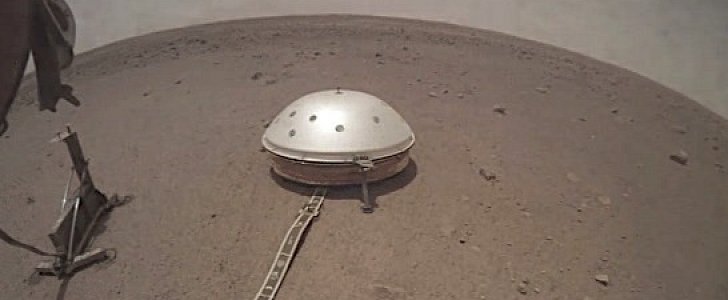NASA says the entire eclipse lasted only 27 seconds, and the photo sequence that makes up the GIF compresses about 14 minutes of footage taken around noon, local time. That means the Martian equivalent of totality comes and goes in a blink of an eye, literally.
In the left bottom of the corner of the image though one can clearly see InSIght’s shadows shifting position as up in the sky, Phobos was stealing the spotlight.
The short clip showing the eclipse is not the only extraordinary set of images sent back by the lander. During the weekend, as it celebrated its 100th day on Mars, the machine captured a sunset on Elysium Planitia.
Earlier in February, courtesy of the InSight, NASA announced another premiere in space exploration, a free-for-all weather service from Mars.
Officially, InSIght is not on Mars to document what’s going on in the sky, but rather to have a closer look at the events unfolding underneath the crust of the planet.
Using an instrument called Seismic Experiment for Interior Structure (SEIS), the lander will attempt to measure the ground motions over a wide range of frequencies to give Earthlings a better understanding of Mars quakes.
Another tool, RISE (Rotation and Interior Structure Experiment), will use the spacecraft's radio connection with Earth to assess perturbations of Mars' rotation axis, and the Heat Flow and Physical Properties Package (HP3) will determine the amount of heat escaping from the planet's interior.
@ Blink and you’ll miss it...@
— NASA InSight (@NASAInSight) 12 martie 2019
I’ve been eclipse-watching on Mars! Watch this series of pics closely, as shadows move and brightness briefly dips when Mars’ moon Phobos passes in front of the Sun. pic.twitter.com/nmPBlJhDNh
La sonde @NASAInSight vient de célébrer ses 100 premiers sols sur Mars ! Le bras robotique est en train de réaliser un panorama complet du site d'atterrissage, et les images du sol 101 montrent le coucher de notre Soleil sur les déserts immenses et silencieux de la planète rouge pic.twitter.com/NAfj9Wiu97
— SEIS (@InSight_IPGP) 11 martie 2019

